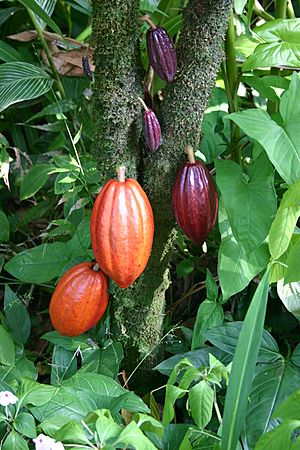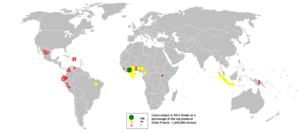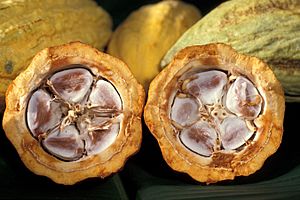Cocoa production in Ivory Coast facts for kids
The Ivory Coast (also known as Côte d'Ivoire) is the world's biggest producer and exporter of cocoa beans. These beans are the main ingredient used to make delicious chocolate! As of 2012, Ivory Coast supplied 38% of all the cocoa produced globally.
Most of the world's cocoa comes from West Africa. Ivory Coast alone produced 1.8 million tonnes of cocoa in 2017. Other nearby countries like Ghana, Nigeria, Cameroon, and Togo also produce a lot, adding another 1.55 million tonnes together. Ivory Coast became the top cocoa producer in 1978, taking over from Ghana. Today, cocoa is super important for Ivory Coast, bringing in 40% of the money from its exports.
Outside of Africa, Indonesia is a major cocoa producer. It grew from almost no cocoa farming in the 1970s to one of the biggest producers by the early 2000s. Big chocolate companies like Cadbury, Hershey's, and Nestle buy cocoa from Ivory Coast. This helps set the world prices for cocoa beans.
Contents
The Amazing Cocoa Tree
The cocoa tree, officially called Theobroma cacao, loves shady places. It naturally grows in the understory (the layer of plants below the main canopy) of rainforests. You can find it growing in the foothills of the Andes mountains and near big rivers like the Amazon and Orinoco in South America.
These trees grow best in areas that are not too high up, have good soil, and are always humid, which is typical for tropical regions. What's cool about cocoa trees is that their fruit, the cocoa pods, grow directly on the trunk and older branches! This is called cauliflory.
How Cocoa Beans Are Farmed
Quick facts for kids Top Cocoa Beans producers |
|
|---|---|
| in 2012 | |
| Numbers in million metric tonnes | |
| 1.650 | |
| 0.936 | |
| 0.879 | |
| 0.383 | |
| 0.256 | |
| 0.253 | |
| 0.133 | |
| 0.083 | |
| 0.072 | |
| 0.067 | |
|
|
|
| World total | 4.928 |
| Source: UN Food and Agriculture Organization | |
In Ivory Coast, most cocoa is grown by small farmers. They usually plant cocoa on small farms, about 1 to 3 hectares in size.
When enough cocoa pods are ripe, farmers harvest them. They open the pods to get out the seeds and the soft, white pulp. The seeds and pulp are then usually left to ferment on the farm. This fermentation process is very important for the flavor of the chocolate later! After fermenting, the seeds are dried, often in a central spot.
Once the seeds are dry, a local buyer, called a "traitant," comes to purchase them. These buyers travel between villages, weighing and collecting the cocoa crop. The traitant then takes the cocoa to a warehouse in a bigger town or city. From there, major exporters buy the dried beans and arrange for them to be shipped out of Ivory Coast to other countries.
This whole process involves many people. It starts with the farmer and their family members who work in the fields. Then there are local buyers and middlemen. Finally, the big exporters get the cocoa onto ships.
Making Cocoa Fair for Everyone
In West Africa, especially in Ghana and Ivory Coast, there have been concerns about how some children are involved in cocoa farming. In 2018, there were efforts to improve conditions for these young workers. However, challenges like poverty, lack of schools, and increasing demand for cocoa made it difficult. Many organizations are working hard to make sure cocoa farming is fair and safe for everyone involved, especially children.
Protecting Our Planet: Cocoa and Forests
Between 1960 and 2010, over 80% of Ivory Coast's forests disappeared. A big reason for this is cocoa farming. A lot of the cocoa exported from Ivory Coast is grown illegally in protected forest reserves and national parks.
Farmers sometimes clear the natural plants in these "protected" areas. They plant cocoa trees and even light fires at the roots of taller trees to destroy them. This allows more sunlight to reach the cocoa plants, which need a lot of light to grow well.
This deforestation (clearing of forests) because of cocoa production has also put wildlife in danger. Ivory Coast used to be famous for its amazing variety of animals and plants. But illegal cocoa farming has harmed this rich natural environment. Even the homes of chimpanzees are being destroyed. Studies have shown that many protected areas have lost all their primate populations due to cocoa production.
For example, Mount Peko National Park has seen a lot of forest destruction. This was mostly caused by cocoa farming. It's estimated that 10,000 tonnes of cocoa, worth over $28 million, were produced illegally from this park each year. About 30,000 people were living there illegally to farm cocoa.
Images for kids





